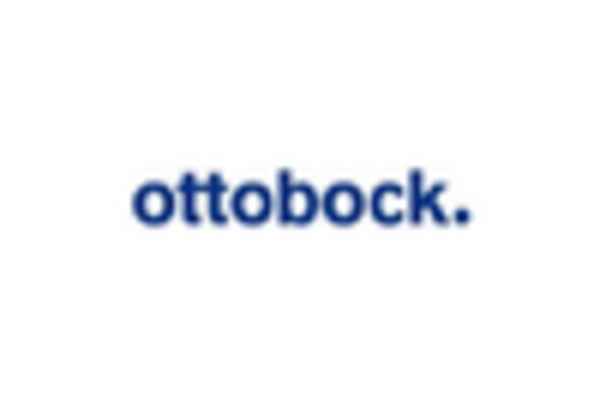Growth in Sports Participation
The surge in sports participation across various age groups is a significant driver for the Orthopedic Splints Market. As more individuals engage in recreational and competitive sports, the incidence of sports-related injuries has also risen. Data indicates that sports injuries account for a substantial portion of orthopedic consultations, necessitating the use of splints for effective management. This trend is particularly evident among youth and amateur athletes, who are increasingly seeking protective gear to prevent injuries. Consequently, the Orthopedic Splints Market is poised for growth as manufacturers cater to this expanding demographic, offering specialized products designed for sports-related applications.
Expansion of E-commerce Platforms
The expansion of e-commerce platforms is transforming the way orthopedic products are marketed and sold, thereby influencing the Orthopedic Splints Market. Online retailing offers consumers greater accessibility to a wide range of orthopedic splints, often at competitive prices. This shift towards digital shopping is particularly appealing to younger demographics who prefer the convenience of online purchases. Market data suggests that e-commerce sales in the orthopedic sector are expected to grow significantly, as more consumers turn to online platforms for their healthcare needs. As a result, the Orthopedic Splints Market is likely to adapt to this trend, enhancing online presence and distribution strategies.
Advancements in Material Technology
Innovations in material technology are significantly influencing the Orthopedic Splints Market. The development of lightweight, durable, and breathable materials enhances patient comfort and compliance. For instance, the introduction of thermoplastic materials allows for custom molding, which improves the fit and effectiveness of splints. Market data suggests that the demand for such advanced materials is on the rise, with a projected increase in market share for splints made from these innovative substances. As manufacturers continue to invest in research and development, the Orthopedic Splints Market is likely to benefit from these advancements, leading to improved product offerings.
Increased Awareness of Orthopedic Health
There is a growing awareness of orthopedic health and injury prevention, which is positively impacting the Orthopedic Splints Market. Educational campaigns and initiatives by healthcare organizations are informing the public about the importance of early intervention and proper treatment for musculoskeletal injuries. This heightened awareness is leading to increased consultations with healthcare professionals, resulting in a higher demand for orthopedic splints. Market analysis indicates that as individuals become more proactive about their health, the Orthopedic Splints Market is likely to see a corresponding rise in product sales, driven by informed consumers seeking effective solutions.
Rising Incidence of Musculoskeletal Disorders
The increasing prevalence of musculoskeletal disorders is a notable driver for the Orthopedic Splints Market. Conditions such as arthritis, fractures, and tendon injuries are becoming more common, particularly among older adults. According to recent data, musculoskeletal disorders affect millions worldwide, leading to a heightened demand for orthopedic solutions. This trend is likely to continue as the population ages, with projections indicating that by 2030, nearly 1 in 5 individuals will be over the age of 65. Consequently, the Orthopedic Splints Market is expected to experience substantial growth as healthcare providers seek effective treatment options for these conditions.


















Leave a Comment